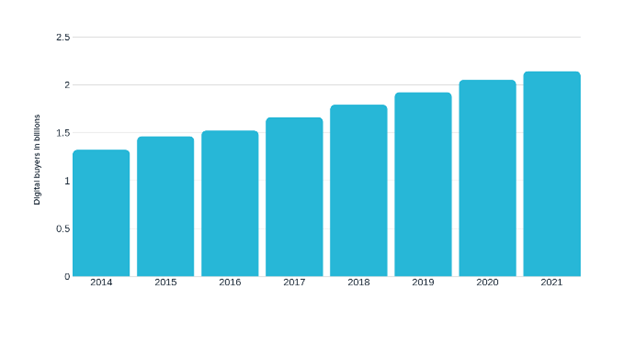The internet has transformed the way businesses are run; one sector that has got a big boost is eCommerce. Now, unlike before, an eCommerce store can reach out to customers across borders and countries.
The fact that the internet made the world a global village also created risks to the conduct of business. Dropshipping has its own risks, though they may be minimal if you put it side by side with other eCommerce business models.
Is this the only reason why people crave the dropshipping model?

The very first thing is the revelation from Statista that the number of online shoppers will rise to 2.14 billion in 2021.

Also, according to a study by Grand View Research, Inc, the drop shipping industry is projected to hit a market valuation of $ 557.9 billion before 2025, registering a CAGR of 28.8%. This is in addition to the low startup cost requirement, which makes it very appealing and appropriate for newcomers in the eCommerce industry.
It also has the advantage of not requiring a large space for goods storage by operators, since the need for a warehouse and even shipping is on the manufacturer. Dropshipping is also going into full automation and that means you can integrate application programming interface (API) to bypass processes such as file transfer protocol (FTP), excel, or any manual workflows: API will ensure that you avoid all forms of manual mistakes.
Notwithstanding these advantages that make dropshipping viable, there is every need to do away or reduce the risks in dropshipping to the barest minimum.
Here are five risks and actionable ways you can go about minimizing or eliminating them in the dropshipping model:
- Product and suppliers’ issues
As you don’t outrightly own the goods you are going to sell, and you depend on suppliers, there will be instances of disappointments. But this is quite avoidable; what you need is an effective vetting strategy and criteria.
These will ensure that you can separate the “wheat from the chaff.” You will know which suppliers are reliable and what products you can get from them.
If you are on top of your game, you will not run out of products and suppliers.
These are some precautions you need to take to ensure you always deliver on your promise:
- Don’t go for a product that people don’t need or demand.
- Bulky products may be difficult to handle, so you need to consider optimally-sized packages for the product you sell to cut down on the weight and cost of shipping goods, also be mindful of the expiry dates of the products you want to drop-ship to avoid spoilage en route.
- The product you want to dropship should not be very common, and it shouldn’t be a product that bigger brands sell since their prices will knock you off.
- Whatever product you intend to dropship, ensure it has good attributes that you can use to showcase it to customers.
- Government’s policies and regulations
Dropshipping cuts across borders and countries, and since there are different regulations and guidelines about what you can import or export, a drop shipper must be very cautious when posting products. For instance, even if the FDA OKed any, and all CBD products tomorrow, that does not mean that you can sell to customers in every state in the U.S.
Each state has its own set of regulations on hemp and CBD products, creating a patchwork of regulations. Governments can also impose tariffs on particular goods at any point in time that can lead to some products being taken off the importation the country’s importation list.
For instance, the U.S. unilateral tariffs on China diverted trade flows from China. Since the government should know what is best for the country, your duty as a drop shipper is to constantly monitor the political and economic policies of the government.
If a policy will hurt your trade in some countries, you ensure that you don’t send products to such countries. You can always look out for other countries where your business will thrive.
- Financial frauds
Dropshipping business depends so much on suppliers, a drop shipper, and a supplier work more like partners. For this reason, there must be a strong bond of trust and loyalty.
Incidentally, you can come across some greedy suppliers who will want to scam you, especially if you are a beginner. If you are not able to meet up with your customers’ demands, especially when they have committed funds to the business, you stand the risk of litigation.
To ensure you don’t fall into this sort of problem, you must endeavor to have reputable and trusted suppliers. There are signs you can look out for and also the ratings of the company you want to engage will be of immense help.
In the end, only do business with suppliers you can trust, those who come with high positive reviews and ratings.
Some important factors that you look for in suppliers include:
- They must be either manufacturers or wholesalers.
- They have a well-laid out policy for product returns and money refunds.
- They have a good channel of communication and feedback program.
- They must come with huge positive reviews and excellent seller ratings.
- They’re agreeable to sending you sample orders.
- They don’t insist on bulk order purchases.
- Order fulfillment
An area that can be very worrisome is when you have numerous orders from customers, and you are not able to supply them. This could be due to downtime with the manufacturer or the supplier does not have enough inventory.
Customers you disappoint this way may churn your brand forever. To forestall this from happening, you need to have backup suppliers apart from your primary suppliers.
Before contracting backup suppliers, you must have attested to the quality of their products, reviews, and ratings, just like you did with your primary suppliers. Your best selling-products must never go out of stock.
- Cybersecurity threats
This may be the biggest source of risk you may have to contend with. As you are transacting online, a lot of data and customers’ information will be at your disposal. You are a good target for hackers.
Phishing is today’s biggest cybersecurity threat. The 2019 Verizon Data Breach Investigations Report says that nearly a third of all cybersecurity breaches in 2019, involved phishing. Hackers are becoming tech-savvier and getting better at phishing.
One way they launch their attacks now is by registering fake domains that are similar to real websites. An unsuspecting customer may not notice the difference and can be deceived into clicking on their link.
While it’s not still very easy to curb their nefarious activities, you can ensure you are implementing the world’s best standards in mitigating cyberattacks. It’s also important you create the necessary awareness among your customers so that they will be wary of clicking any suspicious-looking link.
Conclusion
This is definitely not an exhaustive list of risks and measures to minimize them in the dropshipping industry, however, these five are very important and will put your business in good stead. Dropshipping like every other eCommerce business needs the integration of risk management.
Digital & Social Articles on Business 2 Community
(62)
Report Post




